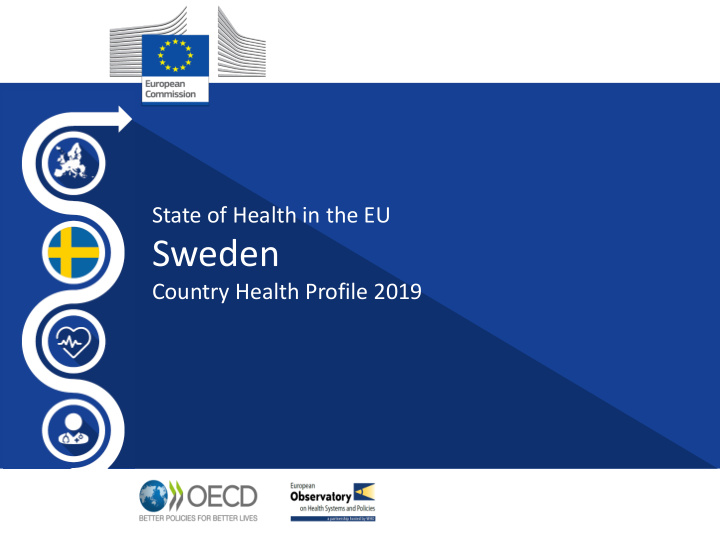



State of Health in the EU Sweden Country Health Profile 2019
Country Health Profile
Health in Sweden
LE in Sweden is among the highest in the EU • LE in Sweden is 1.5 years above the EU average, but it has increased over the past 15 years at a lower rate than in most other countries • Gender gap in LE is among the lowest in the EU • Education gap in LE are low but have increased slightly over the past decade
CV diseases account for the majority of deaths • Stroke and IHD account for 20% of all deaths in Sweden • Cancer is the second most important cause of deaths • Mortality rates from AD have increased ubstantially over the pat 15 years: better diagnosis, population ageing, change in coding practices
Swedes live longer than before, but not all remain healthy in old age Nearly half of Swedes aged 65 and over report having at least one chronic condition (less than in the EU as a whole) but this does not necessarily prevent them from living a normal and independent life
Risk Factors
Child overweight and obesity and physical inactivity are growing public health issues in Sweden
Behavioral risk factors account for more than one-third of all deaths • Smoking among adults has decreased: only 10% of adults smoked daily in 2017, down from 14% in 2010 (snuff not included) • Alcohol consumption has also decreased over the past decade but regular binge drinking is declared by one in five adults • Obesity rate among adults has increased slightly in recent years but remains below the EU average • Conversely, overweight and obesity among adolescents is a growing problem: nearly one in five were overweight or obese in 2013-14, higher than the EU average
Health system in Sweden
Sweden spends more on health than most other EU countries • Health spending in Sweden is high, mostly funded from public sources (84% vs 79% in the EU) • 11% of GDP is allocated to health (third highest in the EU)
Outpatient care is the main category of health spending, followed by long-term care The repartition of health budget reflects the focus made on primary care (inpatient care accounts for only 22% of heath spending while it is close to 30% in the EU as a whole
Sweden has a relatively high number of physicians and nurses Despite a rather high number of doctors, only one in seven is a GP
Effectiveness of the health system
Low mortality from preventable and treatable causes indicates an effective health system Strong public health policies explain the low levels of mortality from preventable causes
Vaccination rate is high among children, but lower among older people Vaccination system is successful among children but influenza vaccination among adults has stalled and remains below recommended targets
Hospitals generally provide high-quality acute care The level of citizens’ satisfaction with hospital care is high in Sweden, reflecting the good performance indicators
Low rates of hospital admissions reflect a shift from inpatient to outpatient care
Accessibility
Out-of-pocket spending is mainly on pharmaceuticals, dental care and outpatient care • The co-payment level is similar to the EU average • Co-payment ceiling systems help to limit adverse effects of user fees
Unmet medical care needs are low • Unmet medical needs are low but tend to be higher among low income groups • Unmet dental care needs are higher and the authorities are trying to address this issue
Waiting times for specialist consultation and treatment are longer in some regions
Resilience
Ageing population will put pressure on the Swedish health and LTC systems • Substantial budgetary pressures are expected: • +1.7p.p. of GDP by 2070 for LTC and • +1p.p. for public spending on health • Further efficiency gains will have to be identified: • Pharmaceuticals • Hospital and care coordination • Digital care
Sweden has managed to shift large parts of care away from inpatient care • Sweden has the lowest bed per population ratio, ALOS is also much lower • Important uptake of day surgery
Main messages
Main messages Swedes live longer and healthier lives. Gender and socio-economic disparities persist but are less marked than in the EU as a whole. CVD, Health cancer and neurodegenerative diseases are the leading causes of death. Comprehensive public health and preventive services helped to bring tobacco and alcohol consumption at levels among the lowest in the EU. Risk Factors Overweight and obesity remain a challenge, particularly in children. The Swedish health system delivers high quality care and gives a Effectiveness preeminent role to the primary care sector. Access is overall good, with low levels of unmet needs and limited Accessibility OOPs. Yet, waiting lists remain a political issue and calls for further attention.
ec.europa.eu/health/state oecd.org/health/health-systems/country-health-profiles-EU.htm euro.who.int/en/about-us/partners/observatory/publications/country-health-profiles
Recommend
More recommend